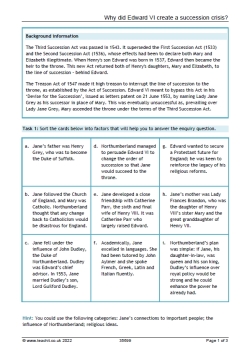Why did Edward VI create a succession crisis?

A card sort activity to help KS3 or A-level students answer the enquiry question and and an opinion continuum for the exam-style question: ‘Edward VI caused a succession crisis in England purely because of the influence of Northumberland.’ How far do you agree?
If used at KS3, some support with the writing task would be advisable.
This resource could follow on from What characterised the reign of Edward VI, which explores the challenges faced by the King.
An extract from the resource:
Background information
The Third Succession Act was passed in 1543. It superseded the First Succession Act (1533) and the Second Succession Act (1536), whose effects had been to declare both Mary and Elizabeth illegitimate. When Henry's son Edward was born in 1537, Edward then became the heir to the throne. This new Act returned both of Henry's daughters, Mary and Elizabeth, to the line of succession – behind Edward.
The Treason Act of 1547 made it high treason to interrupt the line of succession to the throne, as established by the Act of Succession. Edward VI meant to bypass this Act in his ‘Devise for the Succession’, issued as letters patent on 21 June 1553, by naming Lady Jane Grey as his successor in place of Mary. This was eventually unsuccessful as, prevailing over Lady Jane Grey, Mary ascended the throne under the terms of the Third Succession Act.
